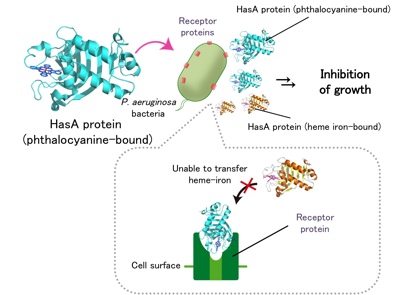Using an artificial protein that contains metal, researchers at Nagoya University in Japan have been able to inhibit the growth of a pathogenic bacterium prevalent in hospitals.
Professor Yoshihito Watanabe (WPI-ITbM, Cooperating Researcher), Associate Professor Osami Shoji, Chikako Shirataki of Nagoya University and their team have found a new method using an artificial metalloprotein (a protein that contains a metal) to inhibit the growth of Pseudomonas aeruginosa bacteria.
The study has been published online in the Angewandte Chemie International Edition.
P. aeruginosa bacteria exist in many aquatic areas and are prevalent in hospitals. Although they do not usually affect healthy people, there is a risk of infection in patients with low immunity. Their high resistance to many antibiotics also makes complete elimination of them extremely difficult. Like humans, bacteria require the uptake of heme iron for their survival, and a protein (HasA) is secreted from bacteria to capture heme from its host. The heme-bound HasA protein transfers heme via receptor proteins on the cell surface of P. aeruginosa.
'Looking closely at the crystal structure of the HasA protein binding heme, we considered the possibility of the HasA protein binding to a metal complex that has a similar structure,' explained Shoji.
'We found synthetic metal complexes that can mimic heme and bind to the HasA protein. To our delight, one of the resulting complexes successfully inhibited growth of P. aeruginosa bacteria.'
.
Inhibition of heme iron uptake of P. aeruginosa by phthalocyanine-bound HasA protein. Copyright: Nagoya University
Shirataki added: 'It took us around four years to discover that phthalocyanine, which is a blue paint used on the surface of the Japanese bullet trains and road signs, could bind competitively to the HasA protein.
'The crystal structures of metal protein complexes helped us to show that the phthalocyanine-bound HasA protein blocks the receptors on the cell surface of the bacterium and thus inhibits the uptake of heme.'
The team is now working to develop a new system to wipe out bacteria by tuning various metal complexes.
